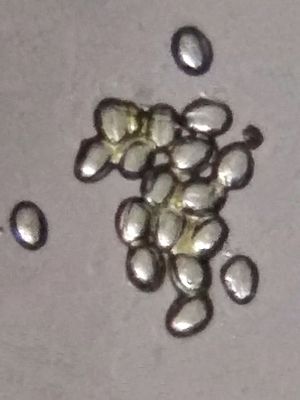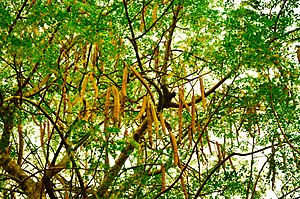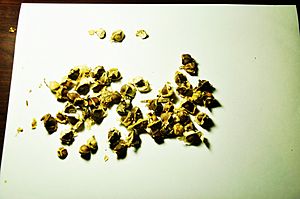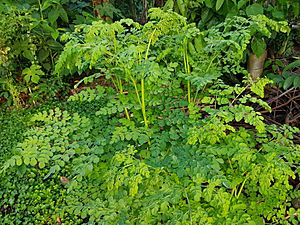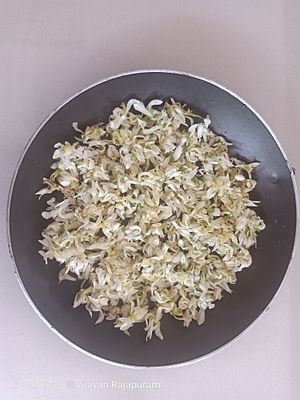Drumstick tree facts for kids
Quick facts for kids Drumstick tree |
|
|---|---|
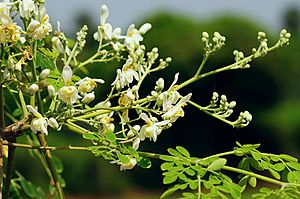 |
|
| Scientific classification | |
| Genus: |
Moringa
|
| Species: |
oleifera
|
| Synonyms | |
|
|
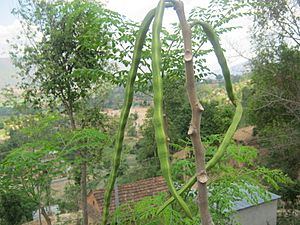
Moringa oleifera is a fast-growing tree that can handle dry weather. It comes from the Indian subcontinent. People often call it moringa, drumstick tree (because its seed pods look like drumsticks), or horseradish tree (because its roots taste a bit like horseradish).
This tree is grown in many places for its young seed pods and leaves. These parts are used as vegetables and in traditional herbal medicine. Moringa is also helpful for water purification. Even though it's listed as an invasive species in some countries, it usually doesn't harm native plants.
Contents
What is the Moringa Tree?
The moringa tree loses its leaves each year. It can grow very fast, reaching up to 10–12 meters (about 33–39 feet) tall. Its trunk can be about 45 cm (18 inches) wide. The bark is whitish-gray and thick. Young branches have purplish or greenish-white, hairy bark.
The tree has a wide top with branches that hang down. Its leaves are feathery, made up of many smaller leaflets.
Moringa Flowers and Fruits
Moringa flowers smell nice and have both male and female parts. They are yellowish-white with thin veins. Each flower is about 1 to 1.5 cm long and 2 cm wide. They grow in hanging clusters that are 10 to 25 cm long.
The tree starts flowering within six months after being planted. In cooler places, it flowers once a year in late spring and early summer. In warmer places with steady rain, it can flower twice a year or even all year long.
The fruit is a long, three-sided brown pod, about 20–45 cm long. Inside, there are dark brown, round seeds, about 1 cm across. The seeds have three thin, papery wings. Wind and water help spread these seeds.
Farmers often cut the trees back to 1–2 meters (3–6 feet) each year. This helps the tree regrow, making it easier to reach the pods and leaves for harvesting.
Where Does Moringa Grow?
Moringa trees grow best in warm, dry areas like the tropics and subtropics. They can grow in many types of soil, but they prefer soil that drains well and is slightly acidic (pH 6.3 to 7.0). If the soil stays too wet, the roots can rot.
Moringa loves sun and heat. It cannot handle freezing temperatures or frost. It's great for dry places because it can grow using just rainwater, without needing expensive watering systems.
| Parameter | Requirement/range |
|---|---|
| Climate | Grows best in tropical or subtropical |
| Altitude | 0 – 2000 m |
| Rainfall | 250 – 3000 mm
Irrigation needed for leaf production if rainfall < 800 mm |
| Soil Type | Loamy, sandy, or sandy-loam |
| Soil pH | pH 5 – 9 |
Main Growing Areas
India is the biggest producer of moringa. It grows about 1.2 million tons of moringa fruits each year.
Moringa is also grown in home gardens and as living fences in South Asia and Southeast Asia. It's often sold in local markets there. In the Philippines and Indonesia, people grow it mainly for its leaves, which they eat. The World Vegetable Center in Taiwan also actively grows moringa for research.
You can find moringa growing wild or farmed in Central America, the Caribbean, parts of South America, Africa, South and Southeast Asia, and some countries in Oceania.
How is Moringa Grown?
Farmers prepare the soil carefully. In tropical areas, it's important to dig shallowly to prevent soil from washing away. For many trees planted close together, plowing is needed. For fewer trees, digging pits and refilling them helps the roots grow well. These pits are usually 30–50 cm deep and 20–40 cm wide.
Planting Moringa
Moringa can be grown from seeds or from cuttings (pieces of a branch). It's easy to plant seeds directly because most moringa seeds will sprout. You can plant them any time of year in soil that drains well. You can also plant cuttings that are 1 meter long and at least 4 cm thick.
Harvesting Moringa
Moringa can be harvested for its leaves, pods, or seeds (for oil). How much it yields depends on the season, the type of moringa, and how much fertilizer and water it gets. Moringa grows best when it's warm and dry, with some extra water and fertilizer.
Farmers harvest moringa by hand using knives or sickles. Cutting the branches back helps the tree grow more and makes it easier to pick the leaves and pods.
Harvesting Fruits
If you plant moringa from cuttings, you might get the first fruits in 6–8 months. Often, the tree doesn't produce many fruits in the first year. By the second year, it might produce around 300 pods, and by the third year, 400–500. A healthy tree can give 1,000 or more pods. In India, one hectare (about 2.5 acres) can produce 31 tons of pods each year.
In North India, fruits ripen in the summer. In South India, flowers and fruits can appear twice a year, so there are two harvests: one from July to September and another from March to April.
Harvesting Leaves
On average, you can get about 6 tons of fresh leaves per hectare per year. The amount harvested changes a lot between the rainy and dry seasons. Leaves and stems can be harvested from young plants 60 days after planting. Then, they can be harvested about seven more times in the year. Each time, the plants are cut back to about 60 cm (2 feet) from the ground. In some places, leaves are harvested every two weeks.
Is Moringa Safe to Eat?
Not much is known about how moringa affects humans if too much is eaten. However, studies show that some parts of the bark and roots might cause problems if eaten in very large amounts. Eating too much moringa leaf extract (more than 3,000 milligrams per kilogram of body weight) could be harmful. But it seems safe at levels below 1,000 mg/kg.
Moringa might also affect how some medicines work, especially those that interact with certain liver enzymes. If you are taking any prescription drugs, it's always a good idea to talk to a doctor before trying new supplements.
What is Moringa Used For?
Moringa is used in many ways in cooking where it grows. You can eat the whole leaves (leaflets, stalks, and stems), the young green pods, the fragrant flowers, and the young seeds and roots.
Moringa Nutrition
| Nutritional value per 100 g (3.5 oz) | |
|---|---|
| Energy | 64 kcal (270 kJ) |
|
8.28 g
|
|
| Dietary fiber | 2.0 g |
|
1.40 g
|
|
|
Protein
|
9.40 g
|
| Vitamins | Quantity
%DV†
|
| Vitamin A equiv. |
47%
378 μg |
| Thiamine (B1) |
22%
0.257 mg |
| Riboflavin (B2) |
55%
0.660 mg |
| Niacin (B3) |
14%
2.220 mg |
| Pantothenic acid (B5) |
3%
0.125 mg |
| Vitamin B6 |
92%
1.200 mg |
| Folate (B9) |
10%
40 μg |
| Vitamin C |
62%
51.7 mg |
| Minerals | Quantity
%DV†
|
| Calcium |
19%
185 mg |
| Iron |
31%
4.00 mg |
| Magnesium |
41%
147 mg |
| Manganese |
17%
0.36 mg |
| Phosphorus |
16%
112 mg |
| Potassium |
11%
337 mg |
| Sodium |
1%
9 mg |
| Zinc |
6%
0.6 mg |
| Other constituents | Quantity |
| Water | 78.66 g |
| †Percentages estimated using US recommendations for adults. | |
| Nutritional value per 100 g (3.5 oz) | |
|---|---|
| Energy | 37 kcal (150 kJ) |
|
8.53 g
|
|
| Dietary fiber | 3.2 g |
|
0.20 g
|
|
|
Protein
|
2.10 g
|
| Vitamins | Quantity
%DV†
|
| Vitamin A equiv. |
1%
4 μg |
| Thiamine (B1) |
5%
0.0530 mg |
| Riboflavin (B2) |
6%
0.074 mg |
| Niacin (B3) |
4%
0.620 mg |
| Pantothenic acid (B5) |
16%
0.794 mg |
| Vitamin B6 |
9%
0.120 mg |
| Folate (B9) |
11%
44 μg |
| Vitamin C |
170%
141.0 mg |
| Minerals | Quantity
%DV†
|
| Calcium |
3%
30 mg |
| Iron |
3%
0.36 mg |
| Magnesium |
13%
45 mg |
| Manganese |
12%
0.259 mg |
| Phosphorus |
7%
50 mg |
| Potassium |
15%
461 mg |
| Sodium |
3%
42 mg |
| Zinc |
5%
0.45 mg |
| Other constituents | Quantity |
| Water | 88.20 g |
| †Percentages estimated using US recommendations for adults. | |
Many parts of the moringa plant are edible:
- Young seed pods, called "drumsticks"
- Leaves
- Mature seeds
- Oil made from seeds
- Flowers
- Roots
The leaves are the most nutritious part. They are a good source of B vitamins, vitamin C, provitamin A (like beta-carotene), vitamin K, manganese, and protein. Cooked moringa leaves have many of these nutrients. Some of the calcium in moringa leaves is in a form called calcium oxalate. The amount of oxalate can vary.
Moringa Seeds and Pods
You can take the seeds out of mature pods, cut them, and cook them. In Nigeria, people like the bitter taste of the seeds. They add them to sauces or eat them as a fried snack. The oil from the seeds can be used in dressings.
Ground moringa seeds can be added to wheat flour to make it richer in protein, iron, and calcium.
Drumstick Pods
The young, thin fruits, known as "drumsticks," are often cooked as a vegetable in South Asia. They are usually partly boiled, cut into shorter pieces, and cooked in a curry or soup until soft. They taste a bit like asparagus or green beans, but sweeter because of the young seeds inside.
Even after boiling, the pods have a lot of vitamin C. They are also a good source of dietary fiber, potassium, magnesium, and manganese.
In India and Bangladesh, drumstick curries are common. People boil the pods in coconut milk and spices. The fruit is also used in lentil soups like dals and sambar.
Because the outer skin is tough, people often chew the drumsticks to get the juices and nutrients, then throw away the tough parts.
Moringa Seed Oil
Mature seeds give 38–40% edible oil called ben oil. This oil is clear, has no smell, and doesn't go bad easily. The young fruits can be boiled, and the oil can be skimmed off the water. The leftover seed material after oil is taken out can be used as fertilizer or to purify water. Moringa seed oil can also be used to make biofuel.
Moringa Leaves
You can eat moringa leaves raw or cooked. They are often added to clear soups, like the Filipino dishes tinola and utan. Finely chopped tender moringa leaves are used to garnish vegetable dishes and salads, like the Kerala dish thoran. They can also be used instead of or with coriander.
Moringa leaves are cooked like spinach. They are often dried and crushed into a powder for soups and sauces.
For long-term use, moringa leaves can be dried and powdered to keep their nutrients. Drying methods like sun, shade, or oven drying work well. The powder is often added to soups, sauces, and smoothies. Because it's so nutritious, moringa leaf powder is used as a dietary supplement. It can also be added to foods like yogurt, cheese, bread, and pastries to make them more nutritious.
-
Dunt-dalun chin-yei, Burmese drumstick sour soup
-
Sabaw sa kalamunggay, a Visayan fish soup from the Philippines with moringa leaves
Other Uses of Moringa
In developing countries, moringa can help improve nutrition and food security. It can also support rural development and good land care. It can be used as forage (food) for livestock.
Moringa trees have been used to fight malnutrition, especially in babies. Since moringa grows well in dry areas, it can provide a healthy food source all year round in many places. About 140 organizations around the world have started moringa growing programs to help with malnutrition, purify water, and make cooking oils.
Moringa oleifera leaf powder can even be as good as soap for hand washing. This is because of natural chemicals in the leaves that have anti-septic and detergent properties. Moringa seeds and the leftover material after oil is pressed out can be used to clean wastewater.
Moringa seed cake, which is left after oil is taken from the seeds, can filter water. It uses a process called flocculation to make drinking water safe. Moringa seeds have special proteins that attract and neutralize tiny particles in cloudy water. This makes the particles clump together, so they are easier to remove by settling or filtration. This is a great, natural way to clean water in places where clean drinking water is hard to find.
Images for kids
-
Branch of a fully grown moringa tree with flowers and leaves (West Bengal)
-
Dry open moringa pod on the ground showing winged seeds (Hawaii)
See also
 In Spanish: Moringa para niños
In Spanish: Moringa para niños



